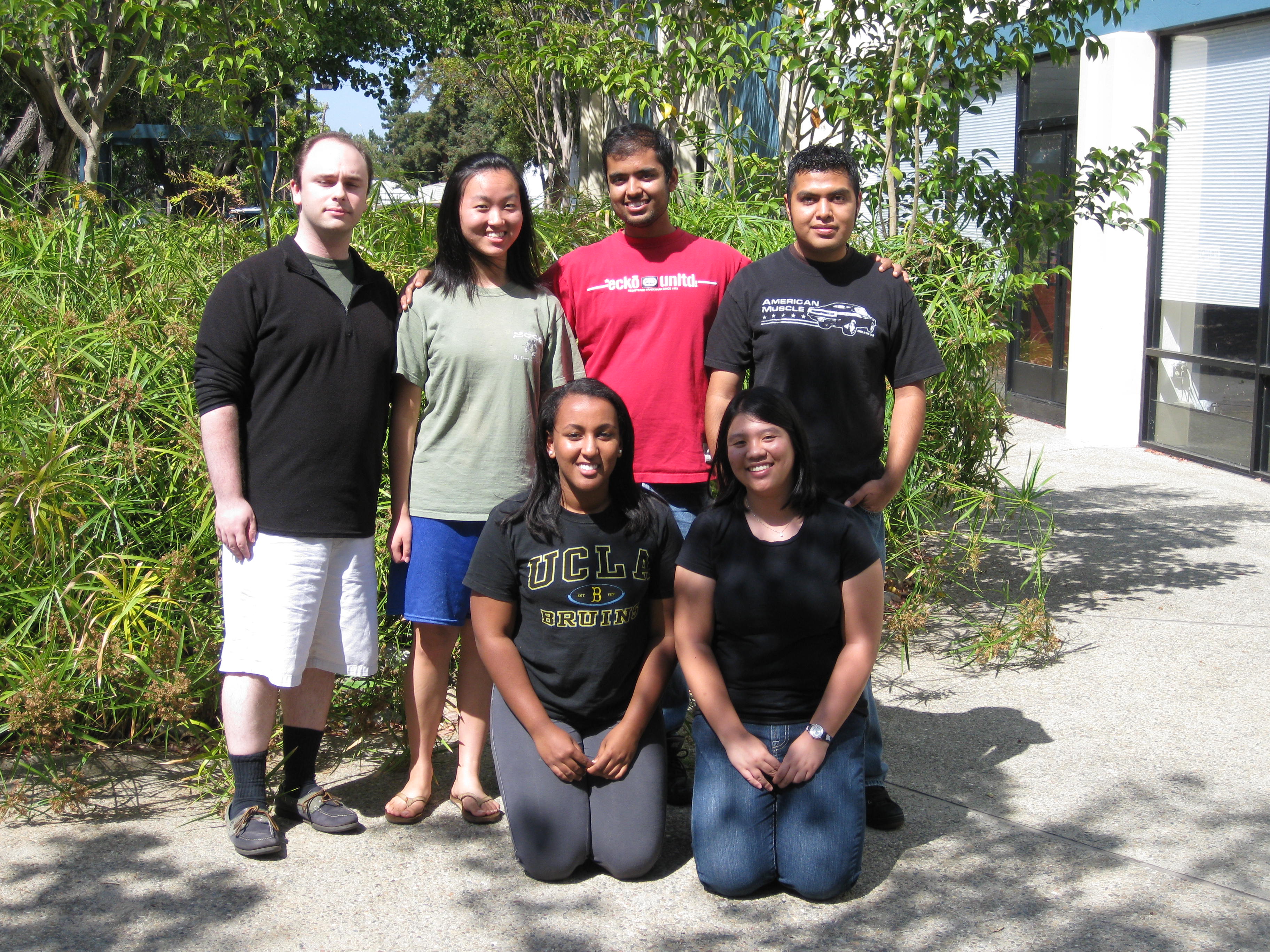Team:Bay Area RSI/Project
From 2009.igem.org
Breast cancer is the second most common type of cancer diagnosed in women. RNAi has proven to be an effective mechanism in the silencing of oncogenes. Therefore, we have attempted to build a viable system for the delivery of RNAi into breast cancer cells. First, we inserted a shRNA sequence coding for the Raf-1 protein into an AAV cassette containing two ITR's, allowing it to reproduce itself in mammalian cells. This cassette was inserted into our chosen vector, the filamentous bacteriophage FUSE-55. An antibody sequence was then added to the phage plasmid near the coat protein sequence in order to target HER2. As an additional feature, we have fused Silicatein and Silintaphin to mStrepavidin, which will bind to a protein tag in the coat, forming silicate structures on the coat of the phage, thereby reducing the immunotoxicity of the bacteriophage in vivo.
| Home | The Team | The Project | Parts Submitted to the Registry | Modeling | Notebook |
|---|
Contents |
Overall project
Breast cancer is the second most common type of cancer diagnosed in women. RNAi has proven to be an effective mechanism in the silencing of oncogenes. Therefore, we have attempted to build a viable system for the delivery of RNAi into breast cancer cells. First, we inserted a shRNA sequence coding for the Raf-1 protein into an AAV cassette containing two ITR's, allowing it to reproduce itself in mammalian cells. This cassette was inserted into our chosen vector, the filamentous bacteriophage FUSE-55. An antibody sequence was then added to the phage plasmid near the coat protein sequence in order to target HER2. As an additional feature, we have fused Silicatein and Silintaphin to mStrepavidin, which will bind to a protein tag in the coat, forming silicate structures on the coat of the phage, thereby reducing the immunotoxicity of the bacteriophage in vivo.
Motivation
Breast cancer is the most common type of cancer diagnosed in women. We have designed a new treatment delivery method using Her2 receptors, which are over-expressed in about a quarter of breast cancers. Breast cancers that over-express Her2 have poorer prognosis than breast cancers without Her2 amplification. Therefore, we have attempted to build a viable system for the delivery of RNAi into breast cancer cells with many copies of the Her2 receptor.
Breast cancer is the seventh leading cause of death of women in the US, and the leading type of cancer diagnosed in women. To date, there are no therapies that specifically target breast cancer cells while delivering RNAi. Instead, current methodologies still rely on surgical excision of the malignant growth, non-specific systemic administration of cytotoxic drugs, or antibodies that induce non-specific apoptosis by an unknown mechanism. Therefore, to address the need for a novel breast cancer therapy, we designed a method of phage-mediated delivery of shRNA using a breast cancer-specific single-chain antibody that specifically targets breast cancer cells. In addition, to decrease the immunologic response to possible phagemid proteins, we encased the phage in a silica coat. We hope that our system opens the gateway for possible novel cancer therapies not premised on the classical technologies.
Experimental Overview
We targeted cells with Her2 amplification and used RNAi to turn off the Raf-1 gene, which is constitutively on in many cancers. First, we inserted an shRNA sequence coding for mRNA causing knockdown of Raf-1 expression into an AAV cassette containing two ITR's, allowing for episomal replication. This cassette was inserted into our chosen vector, the filamentous bacteriophage FUSE55. An antibody sequence was then added to the phage plasmid in order to target Her2. As an additional feature, we have fused Silicatein and Silintaphin to mStreptavidin, which will bind to a protein tag in the coat. This will cause silicate structures to form on the coat of the phage, thereby reducing the immunotoxicity of the bacteriophage in vivo.
Project Details
Phage as a vehicle for gene delivery
Since the beginning of molecular biology, phages have been extensively used as a means to understand the transfer of genetic material. Additionally, owing to their evolutionary perfection for selfish replication, they have small genomes and are amenable to extensive genetic manipulation. As a part of the phage life cycle, the phage injects its genome into host cells and hegemonizes the host cellular machinery. It has been shown that phages can also be used to inject exogenous nucleic acid sequences. Thus, we utilized the phage as a platform for genetic transfer of small interfering RNA (RNAi).1 Another system utilizing EGF receptor displaying phages had been shown to effectively use the RNAi system, and thus receptor targeting by the phage became a crucial part of using the phage as a vehicle for gene delivery.2
Phage Selection
Initially, single-stranded RNA phages such as Q-beta and MS2 appeared to be viable options. The single-stranded form of RNA was crucial in forming the short hairpin structure. In addition, the project design required a phage with a small genome size that has the ability to incorporate various molecules on its coat surface. MS2 appeared to be the best option; however, further research on this phage showed a lack of information on its history of effectiveness in vitro. Since RNA phages did not match our criteria, DNA phages presented themselves as the next logical option. Fuse55 has a single phage chromosome (genome) bearing a single gene III, a coat protein, which accepts foreign DNA inserts and encodes a single type of pIII molecule.3 Having a single coat protein expressed makes the coat of the phage easier to manipulate because only one sequence needs to be altered. It is necessary for the phage to accept foreign DNA so that it displays the Her2 antibody, which will target breast cancer cells.4 Filamentous bacteriophage targeting has been successfully shown to work in the past.5 Also, established protocols on phage display of antibodies exist,6 thus making our specific system easier to achieve.
The incorporation of AAV (adeno-associated virus) ITRs into the fuse55 was another necessary aspect of the project. AAV vectors had been shown to be able to transduce mammalian genes; thus, they affected mammalian cells7, and they had been used in forming the short hairpin RNA structure needed for the RNAi system8. AAV helps inject the shRNA and the ITRs help make the hairpin structure, key for the RNAi process.
Specific Targeting of Breast Cancer Cells via a Her2 single chain antibody (Her2-scfv)
One of the hallmarks of cancer is uncontrolled, aberrant cellular growth. In most cancer types, there is an absence of specific cancer markers. Instead, cancer cells exhibit upregulation or downregulation of endogenous proteins. Thus, specific targeting of cancer cells is problematic. However, tumor specific targeting has produced effective results in the past and has even been shown to produce tumor regression.9 Her2 is over-expressed in about one-fourth of all cases of breast cancer, making it a viable target for our phage. Upon adding Her2-scfv, the phage is required to find a Her2 receptor displayed on a cell, into which it can then transfer genes,10 or, in this case, shRNA.
Silicanization of Phage by Silicatein Alpha/Beta and Silintaphin
Silicatein and silintaphin have been used by sponges that have silica-based structures11 and have been tested to encapsulate other structures such as bacteria12. Silica is known to reduce immunotoxicity in the human body. Silintaphin and silicatein could be harnessed to work together to produce silica structures and encapsulate biological structures,13 which would result in a silicated structure capable of insertion into the body without a strong immune response typical of introducing foreign microbes into the body. Silicatein and silintaphin sequences were inserted into a plasmid separate from the fuse55 plasmid. The two plasmids were incubated together so that the mStreptavidin on the phage coat could latch onto the silica globules produced by the silicatein.
Potential Pitfalls
Cellular environments can affect the outcome of many of the project designs. One of the potential pitfalls would involve the improper folding of the short hairpin sequence coding for KD of Raf-1. Folding is affected by many external factors such as temperature and pH. Another problem could be improper attachment of the silica globules to the strep tag, because the proximity of the globules to the tag may not be ideal, resulting in partially coated phages. Another issue is that Her2 is expressed in normal cells in addition to cancerous cells. This could lead to the Her2-scfv antibody may finding and binding to a normal cell, thus shutting down the normal functioning of Raf-1. As discussed below, Raf-1 is a necessary protein involved in cell proliferation and differentiation, so shutting it down could be hazardous to the normal cell.
Future Plans/Endeavors
Future extensions to the aim of this project could be made in the form of modification of the specific types of receptors or gene sequences targeted for a more effective knockdown of various types of cancer cells. Genes to consider might include sequences involved in cell proliferation, anti-apoptosis, mitotic checkpoints, and so forth. On the other hand, the applications of the RNAi phage delivery system could be tested in different types of cells attacked by various types of cancer. Finally, different materials used in coating of the phage could be utilized and tested for better immunotoxicity response. Some other materials to consider might include gold, which has been known to not cause a reaction of the skin, and could thus be useful in targeting carcinomas.
Background
HER2
Her2 is a member of the erbB family of receptors and a receptor tyrosine kinase. ErbB receptors require a ligand such as a growth factor, and receptor tyrosine kinases add phosphate to tyrosine residues, essentially activating the receptor and allowing it to be a docking site for other proteins to become active. This receptor is involved in signal transduction mechanisms of cell proliferation. The erbB receptors require dimerization upon binding with its ligand EGF. Her2 itself has no ligand, but Her2 is the receptor that can dimerize with any of the other receptors in the family such as Her1 and Her3. Thus it is a favorite in terms of cancer because it is ligand-independent and quick to dimerize. It can become activated and provide a docking site for proteins to become active. One such protein affected by receptor tyrosine kinases is Raf-1.
RAF-1
Raf-1 is a protein kinase involved in the MAP kinase pathway. Raf-1 is a MAP kinase kinase kinase which is activated by Ras. Once activated, it can phosphorylate downstream kinases like MEK1. Ultimately, this pathway helps in cell proliferation, differentiation, and migration, because MEK turns “on” ERK which is a transcription factor for genes such as cell proliferation.
Functional Designs Goals for Fuse55 Plasmid
1. AAV vector is a part of the plasmid because it provides inverted terminal repeats (ITRs) which allow for the formation of hairpin structure due to its symmetry. It also assists in integration of viral DNA into genomic DNA of the host.
2. shRNA RAF-1 sequence forms the hairpin structure when it is transcribed. This allows it to be degraded in the RNAi process causing it to degrade other Raf-1 mRNAs, which match the sequence.
3. Her2 antibody binds to the Her2 receptor on breast cancer cells.
4. mStreptavidin to bind to silica globules and encapsulate the phage.
 "
"

